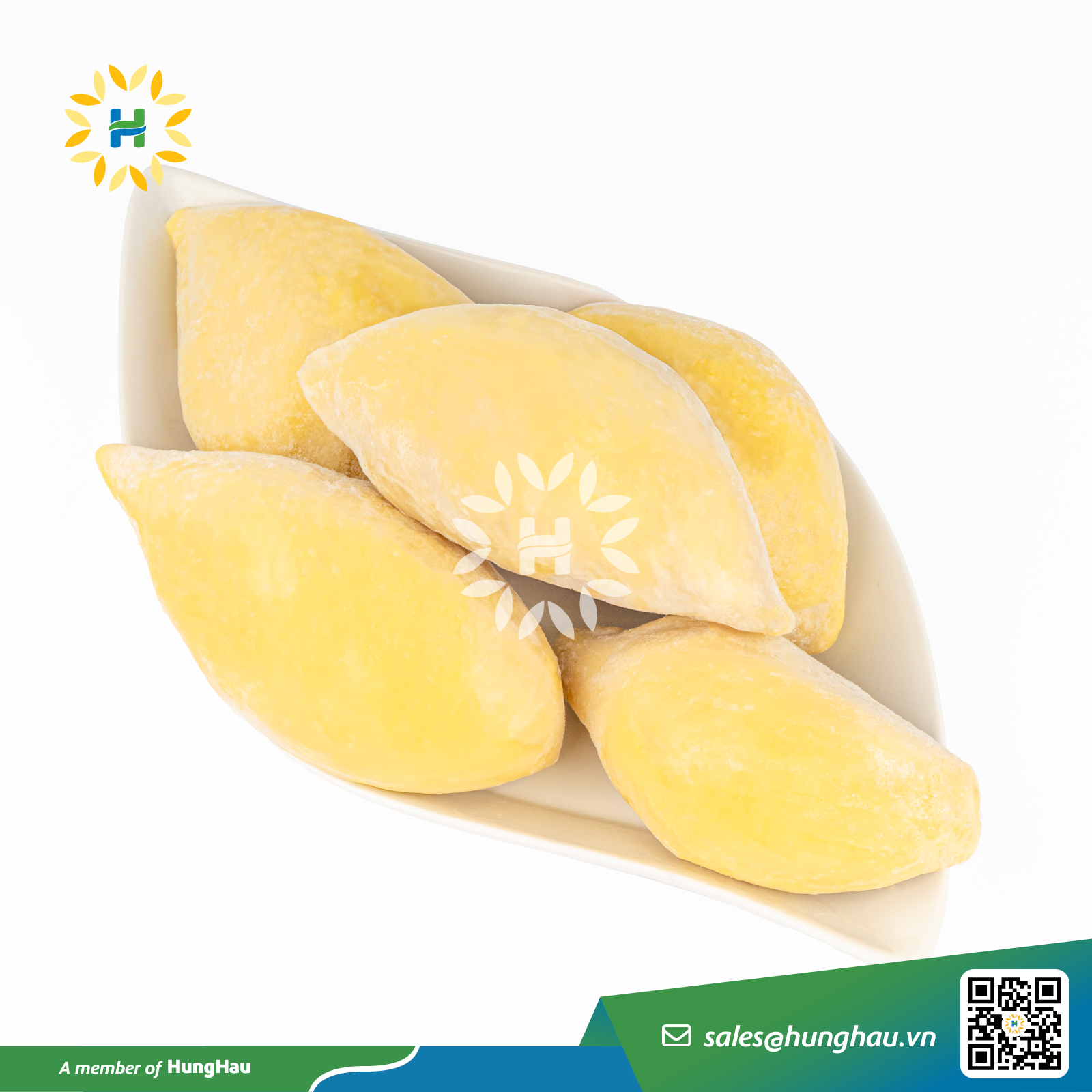Featured News, Market News, News & Event
5 OUTSTANDING ADVANTAGES OF VIETNAMESE FROZEN DURIAN
Vietnamese frozen durian, especially products using IQF (Individual Quick Freezing) technology – quick freezing of each durian segment — is gradually asserting its position in the international market. Not only does it preserve the traditional flavor of the “king of tropical fruits,” but Vietnamese frozen durian also meets modern consumption trends: convenience, safety, and sustainability, contributing value to consumers and the food processing industry.
Advantages of Vietnamese Frozen Durian
Preserves Flavor & Nutrition
Thanks to IQF technology, each durian segment is frozen in an extremely short time, creating very small ice crystals that help minimize damage to the cellular structure of the durian flesh. This allows the frozen durian product to retain its characteristic creamy taste, natural sweetness, and rich aroma as if freshly peeled from the fruit.
Nutrients such as vitamins, potassium, fiber, plant protein, and healthy fats are also preserved almost intact. This is a major advantage compared to traditional preservation methods, which often cause fruits to lose flavor and nutrients after thawing.
Notably, the shelf life of IQF durian can last up to 12–24 months under frozen conditions, reducing losses due to spoilage and meeting year-round consumption demand instead of relying on seasonal availability.

Convenience in Use
Each IQF durian segment is individually packaged and does not stick together, allowing consumers to easily take out only the amount they need — simply thaw the portion required without opening the entire bag.
The IQF frozen durian format is especially suitable for busy individuals, restaurants, cafes, or food processing units. IQF frozen durian can be used to make smoothies, cakes, sweet soups, ice cream, mochi, or simply eaten directly as a dessert fruit.
The flexibility in preparation makes the product easy to integrate into modern culinary models, serving both domestic and export markets.
Export-Standard Quality
Vietnamese frozen durian is produced under strict processes that meet international standards such as GlobalGAP, HACCP, and ISO 22000. Notably, IQF freezing is one of the key criteria for evaluating the quality of frozen agricultural products. Many factories, including HFV Factory (Hung Hau Fruits Co., Ltd.) — a member of Hung Hau Food Joint Stock Company — currently possess modern agricultural production and processing lines applying the most advanced IQF quick freezing technology to ensure export-standard quality in every product.
Frozen fruit and vegetable products from Hung Hau Foods Joint stock Company (HungHau Foods) have been exported to over 80 countries and territories, including demanding markets such as China, South Korea, Japan, the EU, and the US — where regulations on plant quarantine and food safety are very strict. This is proof of the quality and reputation of Vietnamese durian on the global agricultural map.
Additionally, thanks to the application of IQF, the products suffer less damage, have attractive colors, and low loss rates — helping businesses increase productivity and minimize risks during long-term transportation and storage.

Competitive Pricing
Compared to fresh durian or frozen durian products from Thailand — a country with a strong durian industry — Vietnamese frozen durian has a price advantage due to reasonable labor costs, abundant raw material regions, and an increasingly developed logistics system. Vietnam has large durian growing areas in the South, including the two main export varieties: Ri6 and Monthong durian.
Competitive pricing makes the product more accessible to a wide range of customers, from individuals to small and medium-sized F&B businesses. Moreover, diverse packaging options (100g, 500g, 1kg, large cartons) facilitate market expansion, from retail to wholesale, from supermarkets to e-commerce.
Environmentally Friendly
Besides extending shelf life, frozen durian also helps reduce food waste. While fresh durian spoils quickly if not consumed in time, frozen products can be stored long-term, limiting losses caused by spoilage, cracking, or impact during transportation.
Furthermore, many businesses are switching to environmentally friendly packaging that is easy to recycle or biodegradable, helping reduce plastic waste in the frozen food industry.
The “green consumption” trend is increasingly gaining attention in markets such as the EU, Japan, and South Korea, creating opportunities for Vietnamese frozen durian to reach environmentally conscious customer segments.

Why Prioritize IQF Frozen Durian
IQF technology is not only a preservation solution but also a tool to elevate the value of agricultural products. Compared to traditional freezing (block freezing), IQF offers many benefits: no clumping of segments, no deformation, and retains the original appearance after thawing.
IQF products are easily applied in the food processing industry, providing stable raw materials for year-round production. At the same time, the absence of added preservatives also gives consumers peace of mind when using the product.
Potential Markets for Vietnamese Frozen Durian
According to data from the Ministry of Agriculture and Rural Development, Vietnam’s durian exports in 2024 reached 3.3 billion USD, an increase of 43.2% compared to 2023. Durian now accounts for nearly 45% of the total export value of the entire fruit and vegetable sector.
- China: Remains the main market, accounting for about 91% of total export value. Hung Hau Foods Joint Stock Company has obtained the GACC certification for frozen durian to export officially to the Chinese market.
- Japan & South Korea: Favor convenient, safe products with international certifications.
- US & EU: Have strict requirements on traceability and quarantine standards — but have great potential due to the overseas Vietnamese community and consumers who enjoy unique foods.

Developing certified growing areas, investing in post-harvest technology, and completing cold chain logistics are decisive factors for Vietnam to continue expanding its global market share.
Vietnamese frozen durian, with the application of IQF technology (quick freezing of individual segments), is opening a modern and effective direction for the agricultural sector: preserving full flavor and nutritional value, convenient to use, export-standard quality, competitive pricing, and environmentally friendly.
In the context of growing global demand for durian consumption, controlling raw material quality, raising cultivation standards, and investing in post-harvest preservation technology are the keys to helping Vietnamese durian reach international levels.
For importers, the challenge is not only to find a stable supply source but also to choose reputable partners — companies with professional production capacity, rich experience in agricultural export, and deep understanding of the strict requirements of each market.
See more about Hung Hau Foods’s durian products:
IQF Monthong Durian: https://hfoods.vn/product/iqf-monthong-durian/
IQF Ri6 Durian: https://hfoods.vn/product/iqf-ri6-durian/
About Information:
Hung Hau Foods Joint Stock Company (HungHau Foods)
Address: 642 Au Co Street, Bay Hien Ward, Ho Chi Minh City, Vietnam.
References
Ministry of Agriculture and Rural Development of Vietnam (2024). Summary Report on Agricultural Export in 2024. Accessed from: https://www.mard.gov.vn
Plant Protection Department (2024). List of Enterprises and Durian Growing Area Codes Approved for Official Export to China. Accessed from: https://www.ppd.gov.vn
Vietnam News Agency (TTXVN) (2024). “Durian Export Reaches Record 3.3 Billion USD in 2024.” Accessed from: https://vnanet.vn
Hung Hau Foods Joint Stock Company. Introduction to IQF Durian Products and Export Capacity. Accessed from: https://hunghau.vn
VASEP – Vietnam Association of Seafood Exporters and Producers (2023). Application of IQF Technology in Agricultural and Aquatic Product Preservation. Accessed from: https://vasep.com.vn
GlobalG.A.P. (2023). Certification for Vietnam Durian Exporters. Accessed from: https://www.globalgap.org
Food and Agriculture Organization (FAO) (2022). “Freezing of Fruits and Vegetables: An Overview.” Accessed from: https://www.fao.org
